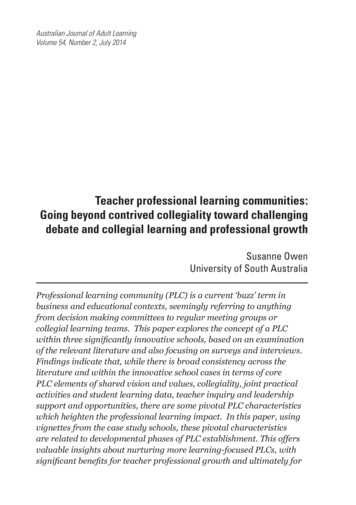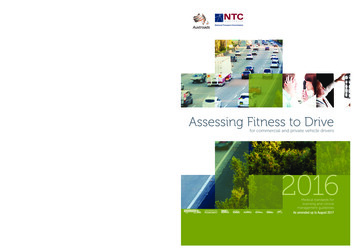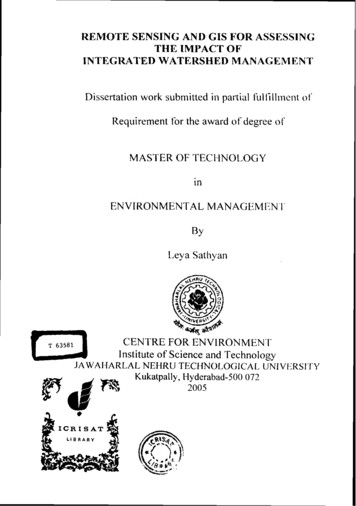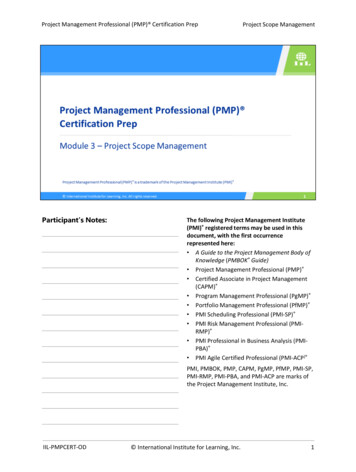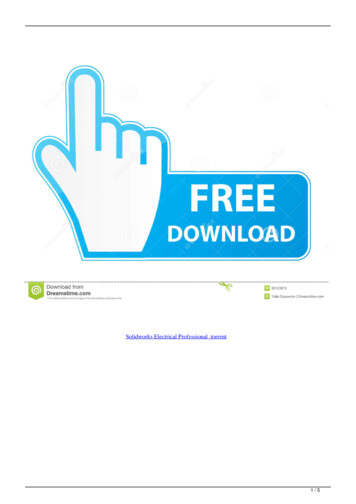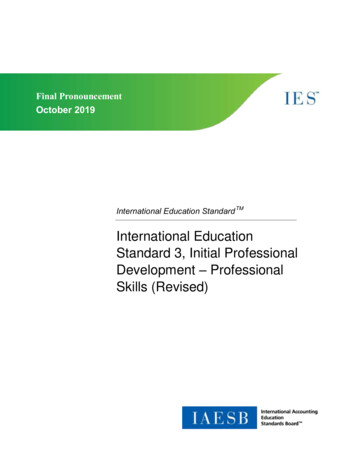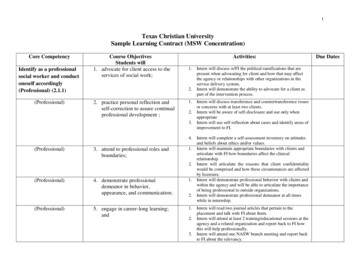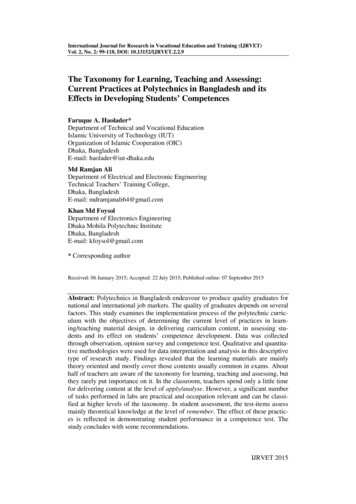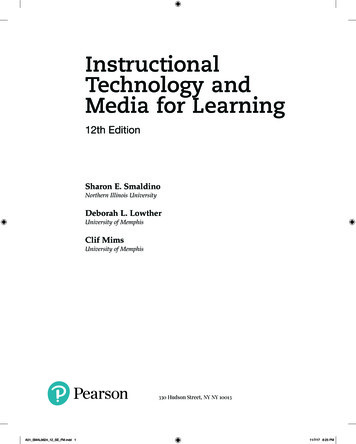
Transcription
Assessing Impact of Professional LearningJoellen KillionSenior AdvisorLearning onwww.learningforward.org
Assessing the Impact of Professional Learning Learn the process for assessing impact of a professional learning initiative; Examine the decisions processes, and tools required to measure the impact andeffectiveness of professional learning; Delineate specific changes in adults necessary to produce the results needed; Develop evaluation questions to guide their work; Examine multiple sources and types of data to use in assessing impact; and Apply their learning to an existing or simulated professional learning initiative.Current methods for assessing the impact of professional learning:I hope to learn . . .Assessing Impactwww.learningforward.org1
Evaluation vs. ResearchSort the cards in your envelope into two groups—Research and Evaluation. Beready to explain your rationale for grouping them.Evaluationvs.ResearchWhat are the differences between evaluation and research?What are our reasons for assessing impact of professional learning?What do we want to know about professional learning?Assessing Impactwww.learningforward.org2
Core components of an EVALUABLE program or project—regardless of its nature1. Goals and ObjectivesStudent Learning Goal(s):Sample student learning goal: Improve student achievement in rational numberson formative unit and benchmark and state assessmentsEducator Learning Goal(s)/Objective(s):Sample student learning goal: Increase teachers’ deep understanding andapplication of rational numbers and related mathematical practices in the design,implementation, reflection, and revision of unit and lesson plans and formativeassessmentsAssessing Impactwww.learningforward.org3
KASAB: Types of Changes(Knowledge, attitudes, skills, aspirations, and eptualunderstanding ofinformation andresearch)Attitudes(beliefs about value ofinformation orstrategies)Skills(capabilities, processes,or strategies to applyknowledge)Aspirations(desires or internalmotivation to engage inpractice)Behavior(consistent applicationof knowledge and skills)Assessing Impactwww.learningforward.org4
2. Theory of ChangeExplains how the change will happen, in what sequence, and with what expected interim and long-term outcomesProfessionalLearningOpportunitiesTeacher interpretationand utilization ofavailable understandingsand skillsTeacher outcomes: Change inpractice No change inpracticeStudent outcomes: Positivechanges No changes NegativechangesStudents’ interpretationand utilization of availableunderstandings and skillsStudentLearningOpportunitiesTimperley, H., Wilson, A., Barrar , H., & Fung, I. (2007) Teacher professional learning and development: Best evidence synthesis iteration. Wellington, NewZealand: Ministry of Education. http://educationcounts.edcentre.govt.nz/goto/BES
Theory of Change [sequence of professional learning components/actions designed to lead to desired results]Assumptions:Assessing Impactwww.learningforward.org6
3. Formative and Summative QuestionsStudent achievement goal(s):SUMMATIVE QUESTION(S):ACTIONS/PROCESSESAssessing Impactwww.learningforward.orgFORMATIVE QUESTIONS7
INITIAL AND INTERMEDIATE OUTCOMES(Learning and Practice)Assessing Impactwww.learningforward.orgFORMATIVE QUESTIONS8
4. Evaluation FrameworkEvaluationData SourcesQuestionsList formativequestions first andsummativequestions lastPeople anddocuments givingyou the informationData CollectionMethodsInstruments/tools(e.g. surveys, logs,interviews,walkthroughs)DataAnalysis MethodsMethods for dataanalysis (e.g.counting,trends/patterns)TimelineFrequency ofcollecting dataPersonsResponsibleWho will collectspecific dataFrom Killion, J. (2008). Assessing Impact: Evaluating Staff Development. Thousand Oaks, CA: Corwin Press.Learning ForwardAcademy 20149
CASE STUDIES FOR EVALUTING PROFESSIONAL LEARNINGThe following case studies are adapted from:Killion, J., Munger, L., & Roy, P. (2004). Training Manual for Assessing Impact:Evaluating Staff Development. Oxford, OH: National Staff Development Council.Case Study One: School-Based Professional Learning ProgramHubbard Middle School staff could no longer ignore its students’ deficiency inexplanatory and argumentative writing after the last state assessment and particularlywith the expected full implementation of the Common Core ELA standards. Theirscores were substantially below the district and state means. However, the state’sholistic scoring system gave them little information about why student scores were solow. Some teachers voluntarily analyzed the returned writing samples to determinewhy their students had not performed well and determined that all students, andespecially their at-risk ones, lacked the ability to develop and organize ideas andemploy language conventions correctly (grammar, punctuation, capitalization,spelling, etc.).Goal: Improve student performance by 30% in two years on explanatory andargumentative writing tasks.Professional Learning PlanTo address these problems, teachers are committed to working hard as a staff toimprove their students’ explanatory and argumentative writing. They plan toadminister both an argumentative and explanatory writing samples in the fall and tokeep writing portfolios for all students. Their professional learning plan is extensive.They will work with the district language arts coordinator to explore current researchabout explanatory and argumentative writing and learn strategies to teach languageconventions and development and organization of ideas. In addition, the teachers willexamine student writing samples several times during the year, observe otherteachers in other schools, watch videotaped lessons that highlight instructionalstrategies and learning tasks to advance students’ ability to develop and organizeideas for explanatory and argumentative writing. They also agreed to establish threestudy groups on adolescent writing across the disciplines, and develop collaborativelesson plans as a team at least once a week to ensure that students are writing everyday in at least one class.The assistant superintendent commends them on their extensive plan to improvestudent explanatory and argumentative writing. She asks several hard questions thatthey want to answer in order to gain her support to establish a student-writing centerat the school. The writing center is designed to provide additional support to studentsLearning ForwardAcademy 201410
on writing skills and will be staffed before and after school by a teacher and studenteditors who will help their fellow students with their writing skills. The assistantsuperintendent wants answers to these questions:1. How do you know you are making a difference in student performance in writingand especially in organization and language conventions?2. Which of the many interventions you are implementing had the greatest impacton classroom instruction?3. How were the interventions selected? On what research did you base yourselection of interventions?4. Are you trying to do too much?Planning the EvaluationGiven these questions, the teachers and principal want to conduct an evaluation oftheir work. They want to design an evaluation to address the questions the assistantsuperintendent asked.As you prepare this evaluation: Identify the types of changes in teachers, administrators, coaches, teacherleaders, district leaders, and district organization that will be necessary toachieve the specified goal. Identify the formative and summative evaluation questions that might beasked to frame the evaluation of this project. Complete a logic model for this project. Complete an evaluation framework for this project.Assessing Impactwww.learningforward.org11
Case Study Two: Implementing the Educator Effectiveness SystemThe district has a newly developed educator evaluation system to comply with thestate requirement that all districts develop a multidimensional, annual evaluationsystem that includes fair and reliable measures of at least measures educatorperformance, educator professional growth, and student achievement as criteria forthe evaluation. The district’s Human Resource Department staff worked with itsteacher association, school administrator organization, and other district officerepresentatives over the last year to develop the districtwide evaluation systems forteachers, non-instructional professional staff, and school administrators. They arecurrently developing the district administrator evaluation system. The local schoolboard adopted the evaluation system and requested annual evaluations on itsimplementation and on how the new evaluation system was contributing toprofessional growth and effectiveness and to student achievement.Goals: By 2016, at least 75% of teachers, principals, and non-instructional professionalstaff achieve at least one level of growth on the educator evaluation rubric in at leastfour of the five domains, including the one on student achievement.By 2016, 100% of educators receive a fair, reliable, and constructive evaluation eachyear that includes constructive feedback and sufficient support to promote continuousgrowth and development including increased student achievement.100% of students achieve one year’s growth for one year of instruction.Professional Learning Plan Prepare all supervising administrators to implement the new educatorevaluation system through a series of online workshops, peer coaching, andreliability testing. Provide ongoing coaching for supervising administrators on the use of theeducator evaluation system. Assess the district’s resources to identify available supports for all domains inthe educator evaluation system. Provide an online resource of educator supports to incorporate into educatorprofessional learning plans to address areas of growth. Develop coaches’ capacity to use the teacher domains and indicators duringtheir coaching interactions with individuals and small groups of teachers. Develop online courses on common areas of growth as a part of the district’sonline professional learning academy.The school board supports this the new evaluation system. They committed to providenecessary resources for its successful implementation, ongoing monitoring, andneeded refinements if data were collected to evaluate the implementation and resultsof the educator evaluation system. They are particularly interested in knowing if theAssessing Impactwww.learningforward.org12
evaluation system is implemented as expected, whether challenges are identified andaddressed, and how the new system is contributing to educators’ ongoing growth andeffectiveness and to student achievement.Planning the EvaluationAs you prepare this evaluation: Identify the types of changes in teachers, administrators, coaches, teacherleaders, district leaders, and district organization that will be necessary toachieve the specified goal. Identify the formative and summative evaluation questions that might beasked to frame the evaluation of this project. Complete a logic model for this project. Complete an evaluation framework for this project.Assessing Impactwww.learningforward.org13
Case Study Three: Implementing the Next Generation Science StandardsThe Curriculum and Instruction Department is planning to implement the newlyadopted Next Generation Science Standards that are a part of the Common Core StateStandards, just adopted by the state board of education. The science curriculumdirector has outlined the program to accomplish full implementation and knows thathe will need a strong evaluation component to ask the school board for the necessaryresources to implement the standards. His plan is to improve both teacher sciencecontent knowledge and science-specific pedagogy in hopes of raising studentachievement. The program will involve about 300 elementary and 100 middle schoolteachers over three years starting with a group of volunteer teachers and adding tothat group each year until the third year in which all teachers who teach science areexpected to participate and demonstrate application of the content and instructionalskills.Goal: Increase student achievement on the 5th and 8th grade science assessment by20% by fully implementing the next generation science standards by 2017.Year One Plan Provide a two-week summer institute for teachers at the local university thatwill be led by scientists and science education faculty. Engage teachers in online support through the school year. Provide ongoing follow-up sessions for teachers differentiated for teachers’level of comfort and expertise with the new science content standards. Coach teachers in developing additional units in core science concepts at eachgrade level, K-3. Provide model lessons for teachers and coach teachers in developingadditional units in key science concepts at each grade level. Focus collaborative team learning on designing authentic application tasks inwhich they employ science knowledge and skills. Build an online repository for teachers of resources available in the communityand the state to support science learning.Year Two Plan Provide an additional summer institute for new-to-the-project teachers. Engage both Year One and Year Two teachers in online teacher-facilitatednetworks to share lessons, student work, support, etc. Provide ongoing follow-up sessions for teachers differentiated for teachers’level of comfort and expertise with the new science content standards. Provide model lessons for Year Two teachers. Coach teachers in developing additional units in core science concepts at eachgrade level, 4-6. Post reviewed and approved units developed by Year One teachers in theAssessing Impactwww.learningforward.org14
online repository so all teachers have access.Continue to add to the online repository for teachers of resources available inthe community and the state to support science learning including teacherdeveloped units, lessons, assessments, and other classroom resources.Year Three Plan Provide a weeklong advanced level summer institute for teachers who haveparticipated in a previous institute. Engage both Year One and Year Two teachers in online teacher-facilitatednetworks to share lessons, student work, support, etc. Provide ongoing follow-up sessions for teachers differentiated for teachers’level of comfort and expertise with the new science content standards. Provide model lessons for Year Three teachers and coaching for teachers newto the professional learning program. Coach teachers in developing additional units in core science concepts at eachgrade level, 7-9. Post reviewed and approved units developed by Year One and Year Twoteachers in the online repository so all teachers have access. Continue to add to the online repository for teachers of resources available inthe community and the state to support science learning including teacherdeveloped units, lessons, assessments, and other classroom resources.Planning the EvaluationAs you prepare this evaluation: Identify the types of changes in teachers, administrators, coaches, teacherleaders, district leaders, and district organization that will be necessary toachieve the specified goal. Identify the formative and summative evaluation questions that might beasked to frame the evaluation of this project. Complete a logic model for this project. Complete an evaluation framework for this projectAssessing Impactwww.learningforward.org15
CASE STUDIES FOR EVALUTING PROFESSIONAL LEARNING The following case studies are adapted from: Killion, J., Munger, L., & Roy, P. (2004). Training Manual for Assessing Impact: Evaluating Staff Development. Oxford, OH: National Staff Development Council. Case Study One: School-Based Professional Learning Program

